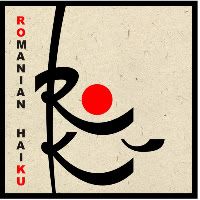În ultimul nr. al revistei
Haiku Reality,
Robert D. Wilson (USA) și
Jasminka Nadaškić-Đorđević (Serbia)
au selectat cele mai bune haiku-uri
primite la redacție. Au contribuit 43
de autori din 15 țări cu 247 poeme.
Un poem de-al româncei Maria Tirenescu
a fost selectat și generos comentat de
R. Wilson la categoria
BEST OF ISSUE (Second Choice)
A swallow
breaking the river mirror –
the flies
O rândunică
spărgând oglinda apei –
musculiţe
lasta
razbija ogledalo reke—
muve
A swallow 3 syllables
breaking the river mirror – 7 syllables
the flies 2 syllables
A swallow: a living object
breaking: an action verb
the river mirror: an allegory referring to a thinly iced over river/a large living body of liquid air
the flies: several insects (living objects)
Although composed of several objects, haiku is not object- (mono, thing) biased. Tirenescu's poem is based upon the verb: "breaking."
Imagine the poet watching a swallow flying above a thinly iced over river, which looked like a mirror. On the watery mirror are several flies. It's a cold winter, the swallow's hungry, and dives down to catch a bite to eat. Mirrors are mirrors, they are projectors of reflections, and not always accurate in the areas of space and physics.
Instead of gulping a fly, he hits the iced over water. If you or I dove at the speed a swallow dives from the height it was hovering in, we'd either crack the ice and die of hypothermia, kill ourselves, or at least be dazed. I assume the bird, due to its small weight, felt much pain, was greatly dazed, and stumbled off the icy mirror (river) like a drunk.
The last line of Tirenescu's haiku provides the juxtaposition, "the flies." Nature is unpredictable and can be misunderstood, by animals and as well as humankind, most of whom kid themselves into believing they are not animals but guardians of nature. Tell that to the victims of the nuclear holocaust set off in Japan on March 11, 2011.
Maria Tirenescu's haiku is about an activity, a process that can be learned from. zoka, the creative, unpredictable, non-static, ever-changing, creative power of nature that Matsuo Basho told his disciples was essential for a haiku to succeed, should be observed, meditated upon, and allowed to teach. I appreciate her using a break (pause) --- after "mirror" at the end of line two, the dashes substituting for the Japanese cutting word . . . a style that generates ma (dreaming room). - Robert D. Wilson
...........................
A swallow - 3 silabe
breaking the river mirror – 7 silabe
the flies -2 silabe
O rândunică : un obiect viu (animat)
spărgând: un verb de acțiune
oglinda râului : o alegorie referitoare la stratul de gheață/sau la un imens organism viu din aer lichid
the flies: câteva insecte/obiecte vii (animate)
Imaginaţi-vă cum poetul urmărește o rândunică zburând deasupra unei râu înghețat care arată ca o oglindă. Pe oglinda apei sunt mai multe insecte în zbor. E o iarnă rece, rândunica e flămândă şi se scufundă pentru a prinde ceva de mâncare. Oglinzile sunt oglinzi, acestea proiectează reflecţii care nu oferă chiar întotdeauna imagini precise ale spaţiilor şi mișcărilor reflectate.
În loc să înghită o muscă, pasărea lovește gheața. Dacă tu sau eu, la viteza rândunicii, ne-am scufunda de la înălțimea la care ea plutește în aer, noi fie am fisura gheaţa imediat şi am muri de hipotermie, sinucigându-ne, fie am ameţi grozav. Se presupune că pasărea, datorită greutății ei mici, a simţit o durere mare, a fost foarte ameţită, şi s-a împleticit de tot pe oglinda de gheață, ca un om beat.
Ultimul rând al haiku-ului relevă juxtapunerea, "insectele". Natura este imprevizibilă şi poate fi înţeleasă greşit, de animale şi, la fel de bine, de oameni, cei mai mulți păcălindu-se crezând că ei nu sunt animale, ci gardieni ai naturii. Asta s-o spună victimelor holocaustului nuclear de pe 11 martie 201 din Japonia.
Haiku-ul Mariei T. lui este despre o activitate, un proces care poate fi învăţat din termenul zoka, non-staticul creativ, imprevizibil, în continuă schimbare, puterea creatoare a naturii, despre care Matsuo Basho a spus ucenicilor săi; pentru ca un haiku să reuşească, era esenţial să fie respectată natura, să se mediteze asupra ei şi să se înveţe de la ea.
Apreciez folosirea pauzei după "oglindă", la sfârşitul versului al doilea, linia de pauză înlocuind kireji-ul japonez. . . Un stil care generează ma (cameră a visării). - Robert D. Wilson
Au mai fost selectate şi poemele:
ion untaru, Romania (Rumunija)
liar!
says the fly kissing
the screen
lažov!
kaže muva ljubeći
ekran
mountain village . . .
the putrid scent of
a condor
planinsko selo...
miris truleži
kondora
tr. SV
Maria Tirenescu, Romania (Rumunija)
Rouă
pe acoperişul şopronului –
cântă un piţigoi
dewdrops
on the shelter roof
titmouse song
rosa
na krovu skloništa
peva senica
tr. SV





Niciun comentariu:
Trimiteți un comentariu